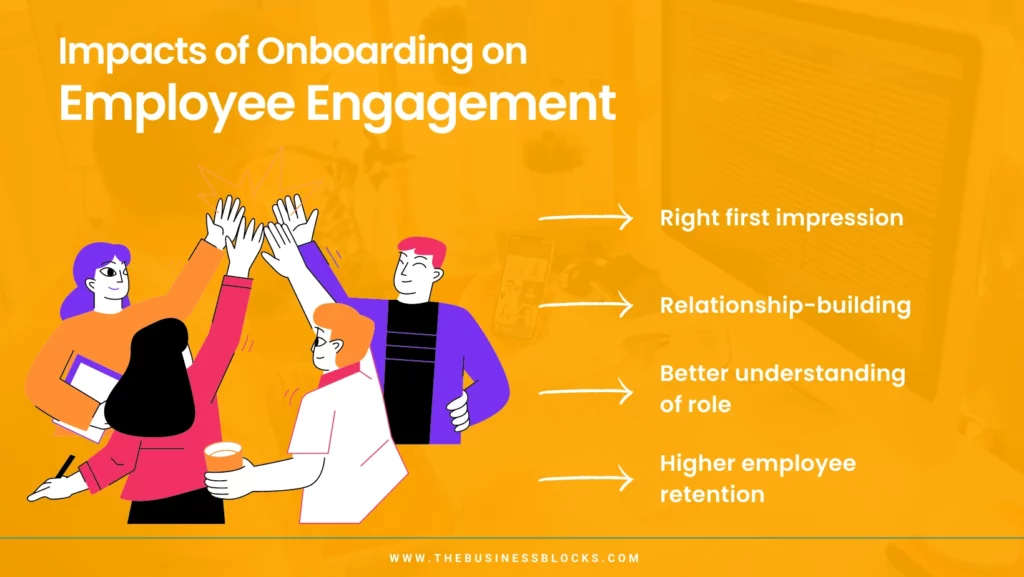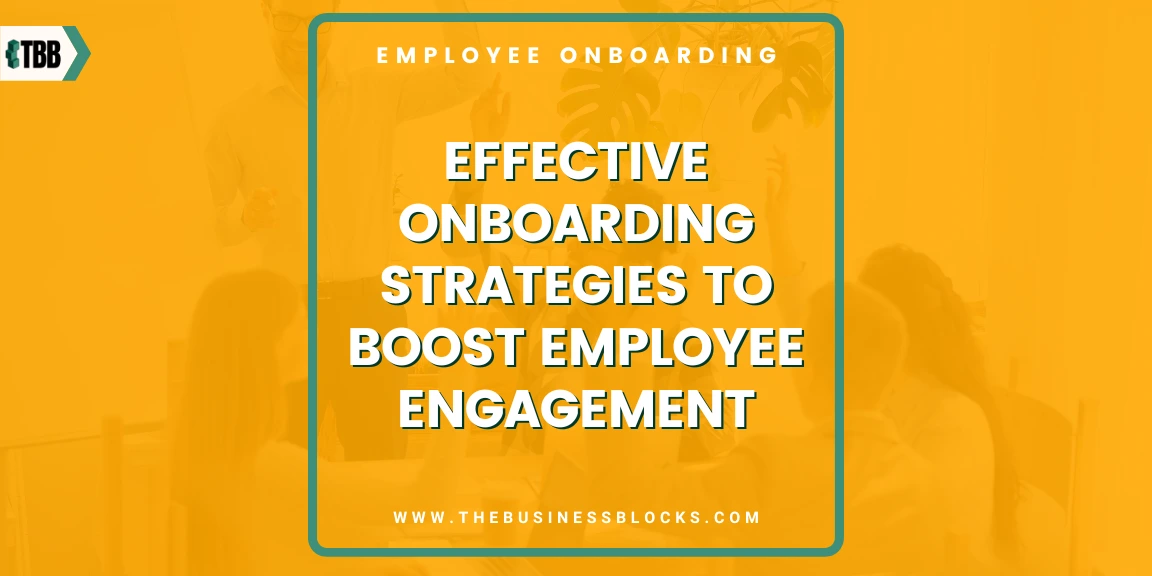Successful companies have one thing in common – highly professional, skilled, and engaged employees. Employee engagement help in increasing the profitability of the company, reducing employee turnover, and boosting job satisfaction and happiness.
Regarding employee engagement, your company’s onboarding process plays a critical role. A positive onboarding experience creates an excellent first impression on your new hires and can lead to higher engagement and retention.
In this blog post, we will delve deeper into how onboarding affects employee engagement, how to create the best onboarding strategies and more. Let’s get started.
What is Employee Onboarding?
In simple terms, employee onboarding is welcoming new employees into your company, helping them acclimate to their new roles, and offering the required training.
A typical onboarding process includes initial orientation, skill and career development and training, and building relationships with colleagues and managers. Onboarding programs aim to set employees up for success and help them learn the ropes, company culture and values, and job expectations.
How Does Onboarding Affect Employee Engagement?

An effective and streamlined onboarding process benefits employees and the company. It helps the employees feel welcomed, valued, and engaged from day one, setting the stage for a long-term and productive working experience with the company.
Here are some of how onboarding affects employee engagement in an organization:
1. It helps create the right first impression
First impressions matter in almost everything. The same is true when you are onboarding new employees in your company. A streamlined and employee-friendly onboarding process helps create a sense of belonging and excitement for the new employee. This, in turn, can lead to higher levels of engagement in the long run.
2. It is important for relationship-building
Employees’ engagement and morale depend on their relationships with colleagues, managers, and juniors. An excellent onboarding process allows new hires to build positive relationships with the people they will work with. Employees who enjoy good camaraderie with their colleagues and have a positive relationship with their managers are likely to be more productive and engaged at work.
3. It helps them understand their role in a better way
The onboarding process helps all new employees understand their roles and responsibilities in a better way. They will have more clarity on how their work contributes to the organization’s larger goals, which can lead to a sense of purpose and more engagement.
4. Good onboarding can lead to higher employee retention
A study conducted by TalentWise presented an interesting insight. According to it, 70% of the corporate employees accepted that they are more likely to stay with the same organization for over three years if their onboarding process was great.
Thus, having a smooth and streamlined onboarding process boosts employee engagement and lowers a company’s employee turnover rate.
Benefits of having a highly engaged team of employees
A study revealed that having highly dedicated and engaged employees increases a company’s profitability by a whopping 21%! Also, poor employee engagement costs $450 – $550 billion every year to the U.S. economy.
Thus, it’s clear that having a team of highly engaged employees is critical for the growth of your company. That said, let’s have a look at some of the major benefits that engaged employees offer:
Higher productivity
Engaged employees are more productive at their workplace. They get tasks done faster and with more efficiency than their colleagues. The higher level of output ultimately leads to better business results.
Better quality of work
Employees who are motivated and engaged at their workplace take pride in their job. Such professionals are more likely to produce high-quality work. This will help you achieve your business goals faster and offer better service and satisfaction to your customers.
More job satisfaction
Engaged employees also have greater job satisfaction and are happier than their disengaged colleagues. More job satisfaction also means employees are more likely to stay with an organization long-term. This reduces recruitment and training costs associated with high turnover rates.
Tips for Creating the Best Onboarding Strategies to Boost Employee Engagement

Now that we have discussed how effective onboarding can boost employee engagement and increase productivity let’s see how you can create an effective new hire onboarding strategy for your business.
1. Start with developing a clear onboarding plan
The first step to developing top-notch and highly effective onboarding strategies starts with a clear onboarding plan. A concise and well-planned onboarding program will help you streamline the entire process, ensure that you are moving in the right direction, and measure results.
2. Leverage advanced technology to automate your onboarding process
Certain onboarding tasks can be unnecessarily time-consuming, especially those related to paperwork. So, make sure to leverage technology and automate repetitive manual tasks. This way, you can provide your new hires with all the necessary resources and documents while saving time. Because the effective onboarding strategy should include a mix of automated and manual tasks, you can also create custom onboarding processes that cater to the specific needs of each employee.
3. Provide opportunities for growth to your employees
Training and development are an integral part of the onboarding process. So, while developing your company’s onboarding strategy, focus on the training and skill development of your new hire. Please allow them to get all the required training and support to excel at their job. This can go a long way in boosting their engagement, morale, and job satisfaction.
4. Ask for feedback
Lastly, don’t forget to ask for feedback from new hires. This will make them feel like a valued part of your organization. While you ask for feedback, ensure to implement the changes suggested by your employees and make adjustments to the onboarding process. This will keep it effective and relevant to new hires’ needs and expectations.
5. Creating Onboarding Checklists
Creating onboarding checklists can help ensure each new hire has completed all the necessary tasks and activities involved in the onboarding process from the start of the hiring process and so on. This could include providing them with important documents, company systems access, or a welcome package.
A strategic onboarding program is key to employee engagement and retention, increasing productivity, and fostering an engaged and committed workforce. With the right onboarding process, you can ensure that your new hires quickly become productive and successful team members.
Frequently Asked Questions about effective onboarding strategies to boost employee engagement
Q: What are the 4 C’s of effective onboarding?
A: The 4 C’s of effective onboarding include the following:
- Compliance: This involves filling up all necessary paperwork and legal requirements for the hiring or recruitment process and onboarding new employees.
- Clarification involves helping new employees understand their roles, responsibilities, and performance expectations.
- Culture: It includes helping the new hire understand the company’s culture, mission, and values.
- Connection is related to allowing new hires to connect with their managers and colleagues.
Q: What are three things companies can do to increase employee engagement?
A: Companies can increase employee engagement by:
- Promoting better work-life balance for their employees,
- Providing opportunities for growth and development,
- Building a positive and supportive work environment.
Q: What if hiring managers need to onboard multiple employees?
A: If hiring managers need to onboard multiple employees, they should consider investing in automation software.
Q: How can onboarding improve employee engagement?
A: Onboarding can improve employee engagement by clearly understanding the organization’s mission and goals and how they can contribute to it.
Conclusion
To sum it up, having effective onboarding strategies in place is necessary for your employees’ long-term engagement and growth. The employee onboarding journey should start as soon as possible and have all the information that new hires need to quickly get up-to-speed on their new job or roles.
Make sure to consider all the tips mentioned above to offer your new hires a streamlined onboarding process and continued opportunities for growth and development. Doing so will go a long way in helping you build a team of engaged and committed employees who will contribute to your organization’s success.

